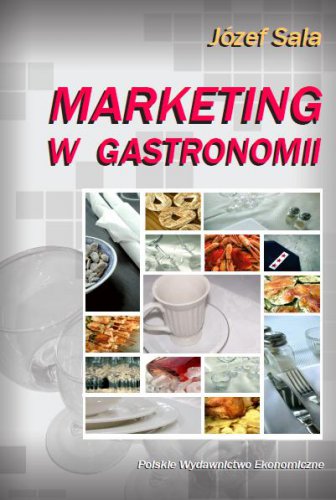Marketing w gastronomii
Publication date: 2011
Place publication: Warszawa
Publication: II zmienione
Binding: paperback
Format: 162x237
Catering industry as a segment within the services sector plays important economic and social roles. By providing food products ready for consumption it may contribute to development of modern lifestyle trends and to improvement of standards of living of contemporary urban societies.
The book is a comprehensive study in the area of marketing in the catering industry.
The Author discussed as follows:
· the notion and the role of catering industry in the market economy,
· the essence and specificity of marketing in the catering industry,
· catering service as a product,
· product strategies in the catering industry, both individual and systemic,
· distribution of catering services,
· pricing in the catering industry,
· promotion of catering services,
· catering services as a component of product in the hospitality industry,
· catering services as a factor of improving competitiveness in the hospitality industry.
The book provides precious knowledge to employees working in hospitality and restaurant business, being also addressed in particular to students of economics and in schools teaching tourism-related courses.
Preface
Cooking has been one of the oldest forms of commercial activity in our civilization. Its origins are rooted in most ancient times, as long ago as the first families, considering that to eat and to drink are man’s very primal and basic needs and to satisfy that need is decisive to human survival. Over the centuries the art of cooking evolved along most variable patterns. Most of the time this development was – and still is – highly dependent on external factors, such as general level of economic development, the level of wealth within a given community, the intensity of tourism traffic and political stabilization. Many countries, e.g. France, Italy, China, or Japan, have written crucial chapters in the history of that industry, enriching and evolving it with new achievements and innovations of the art of cooking. The catering industry in these countries enjoys well-deserved repute and prestige to our days. The catering industry has achieved its full development following the World War 2 in developed countries with viable market economy. Since that time its role in the process of feeding the population has increased and this sector of activity has become a source of significant income on the tourism market.
The catering industry as one link of the sector of services plays important economic and social roles. If it provides the population with fine feeding products, prepared from fresh, high quality ingredients recommended by the science on feeding, it may have beneficial influence upon improvement of living standards of the society. In such case it contributes to modernization of consumption and its evolution through positive trends and transformations. As catering develops in work places, schools, nursery schools, and universities, consumers are offered meals in the right place and time. The activity of canteens run by religious and charity organizations contributes to reduction of the scale of poverty in the field of feeding. Therefore, the evolution of the catering industry has been a driving force in the progress of the food economy, both in tea area of food processing and in that of food consumption.
In every community the food — along with satisfying the basic biological need of the human organism — also performs broader and deeper social functions, being a measure to maintain some specific social relations. Through offering high quality meals and enjoyable lifestyle settings, the catering industry may be a source of prestige. Each culture has its own deeply rooted habits, manners and behaviors in terms of food consumption that are handed over from one generation to another. People eat their meals according to some set of adopted rules, e.g. inviting friends to table and thus consolidating social relationships. The catering industry has also played a key role in the tourism market. By offering catering services, it enables people to travel and participate in tourism traffic. The quality of catering services largely determines the competitiveness of the tourism product in the market. Even the activity of some individual restaurants tends to attract tourists’ interest.
The catering industry in Poland used to suffer serious underdevelopment for decades. Its evident discrimination over the years 1945–1989 resulted in its minor role in feeding the population and in poor quality of services it mustered. It was only in the wake of development of market economy that new conditions were gradually created for healthy operation and growth of that sector. However, despite unprecedented, massive and largely beneficial changes taking place in the years 1989–2010 in the Polish catering industry, both in terms of increasing number of businesses and improving level of services offered, still most company owners and managers active in the field have inadequate professional knowledge about marketing in the catering industry. What is also lacking is the experience in terms of shaping the development of this sector under conditions of intense competition, as is proper research on determinants and specificities of marketing instruments and their application. A variety of publications dealing with this field manage to discuss these problems only partially. This is not enough, considering that in the present condition of high saturation of the network of catering establishments in Poland any manager interested in achieving success should have mastered an extensive knowledge about marketing in that field.
The aim of this publication is to present the essence and the specificity of instruments of marketing in the catering industry and to teach how to apply them in that sector. The book’s basic assumption was that due to a very specific nature of business activity in this industry, the appropriate marketing instruments require different application than in other markets.
The book is addressed to students of schools of tourism and hospitality industry; students of faculties dealing with problems of operation of the services sector. It may also prove useful to personnel employed in catering and hospitality business.
The content of the book is a result of the Author’s long record of interest in that area. In preparing the book, he made a thorough use of Polish and foreign literature, as well as information derived directly from the Internet.
I kindly ask Professor Krystyna Gutkowska, PhD, to accept my gratitude for an insightful review of this book. Her apt remarks and suggestions enabled me to improve the contents of the book.
Józef Sala, PhD
Spis treści
Wstęp
Rozdział 1. Pojęcie i rola gastronomii w gospodarce rynkowej
1.1. Podstawowe pojęcia związane z działalnością gastronomiczną
1.2. Funkcje gastronomii
1.3. Formy gastronomii. Kryteria klasyfikacji zakładów gastronomicznych
1.4. Podsystemy gastronomii w gospodarce rynkowej
1.5. Rola gastronomii w gospodarce rynkowej
1.5.1. Gastronomia jako ogniwo gospodarki żywnościowej i turystycznej w krajach wysoko rozwiniętych
1.5.2. Rola gastronomii na rynku dóbr konsumpcyjnych i usług w Polsce
Rozdział 2. Istota i specyfika marketingu w gastronomii
2.1. Rozwój marketingu w działalności gastronomicznej
2.2. Istota marketingu w gastronomii
2.3. Struktura marketingu-mix w gastronomii
Rozdział 3. Usługa gastronomiczna jako produkt
3.1. Istota i cechy produktu w gastronomii
3.2. Poziomy i elementy produktu w gastronomii
3.3. Metody różnicowania produktu. Pozycjonowanie zakładu gastronomicznego wobec konkurencji
3.4. Cykl życia usług gastronomicznych. Dynamika form organizacyjnych gastronomii
Rozdział 4. Strategie produktu w gastronomii indywidualnej
4.1. Strategia niszy rynkowej jako główny sposób konkurowania niezależnych firm gastronomicznych na rynku
4.2. Strategie produktu w wybranych formach gastronomii indywidualnej
4.2.1. Restauracje
4.2.1.1. Restauracje popularne
4.2.1.2. Restauracje luksusowe
4.2.1.3. Restauracje etniczne
4.2.1.4. Restauracje sławnych osób
4.2.2. Zakłady folklorystyczne
4.2.3. Dyskoteki
4.2.4. Puby
4.2.5. Winiarnie
4.2.6. Kawiarnie
4.2.7. Herbaciarnie
4.2.8. Kluby
4.2.9. Bistro
4.2.10. Tawerny
4.2.11. Bary
Rozdział 5. Strategie produktu w gastronomii systemowej
5.1. Istota i komponenty gastronomii systemowej
5.2. Strategie produktu w zakładach fast food
5.3. Strategia produktu w sieciach prowadzących zakłady typu fast casual
5.4. Strategia produktu w sieciach prowadzących zakłady typu casual dining
5.5. Strategia produktu w sieciach prowadzących bary kawowe
5.6. Strategia produktu w gastronomii handlowej
5.6.1. Usługi gastronomiczne w sieciach domów towarowych
5.6.2. Usługi gastronomiczne w sklepach spożywczych i na stacjach benzynowych
5.6.3. Sieci gastronomiczne w ośrodkach i centrach handlowych
Rozdział 6. Dystrybucja usług gastronomicznych
6.1. Pojęcie i elementy systemu dystrybucji
6.2. Współczesne kierunki rozwoju systemu dystrybucji usług gastronomicznych i ich uwarunkowania
6.3. Podstawowe kanały dystrybucji usług gastronomicznych
6.3.1. Kanały bezpośrednie
6.3.2. Kanały pośrednie
6.3.2.1. Istota kanałów pośrednich
6.3.2.2. Rodzaje i funkcje pośredników w kanałach dystrybucji
6.4. Uwarunkowania i kierunki rozwoju wertykalnych i horyzontalnych systemów marketingu
6.4.1. Determinanty procesów integracji w kanałach dystrybucji
6.4.2. Franchising
6.4.3. Alianse strategiczne
Rozdział 7. Kształtowanie cen
7.1. Pojęcie i elementy ceny
7.2. Czynniki decyzji cenowych w gastronomii
7.3. Podstawowe metody kształtowania cen
7.3.1. Kształtowanie cen oparte na formule kosztowej
7.3.2. Kształtowanie cen zorientowane na konkurencję
7.3.3. Kształtowanie cen zorientowane na popyt
7.4. Różnicowanie cen
7.4.1. Istota i przyczyny różnicowania cen
7.4.2. Różnicowanie cen ze względu na wielkość sprzedaży
7.4.3. Różnicowanie cen ze względu na czas zakupu
7.4.4. Różnicowanie cen ze względu na typ nabywcy
Rozdział 8. Promocja usług gastronomicznych
8.1. Pojęcie i struktura systemu promocji
8.2. Reklama usług gastronomicznych
8.2.1. Istota i rola reklamy na rynku usług gastronomicznych
8.2.2. Organizacja reklamy w firmie gastronomicznej
8.2.3. Zarządzanie reklamą
8.2.3.1. Uwarunkowania i zakres decyzji reklamowych
8.2.3.2. Etapy procesu planowania kampanii reklamowej
8.3. Public relations
8.4. Promocja sprzedaży
8.5. Sprzedaż osobista
Rozdział 9. Usługi gastronomiczne jako komponent produktu w hotelarstwie
9.1. Pojęcie i funkcje hotelarstwa
9.2. Współczesne kierunki rozwoju hotelarstwa
9.3. Rola gastronomii w strukturze produktu w hotelarstwie
Rozdział 10. Usługi gastronomiczne jako czynnik podnoszenia konkurencyjności produktu w hotelarstwie
10.1. Zakres usług gastronomicznych w hotelach
10.2. Gastronomia hotelowa — funkcje i kierunki rozwoju
10.3. Obsługa gości w pokojach i jej rola w podnoszeniu jakości produktu hotelowego
10.4. Organizowanie bankietów i działalność cateringowa
10.5. Czynniki sukcesu w gastronomii hotelowej
10.6. Główne współczesne kierunki rozwoju gastronomii hotelowej
Bibliografia
| Odbiór osobisty | 0 € |
| Kurier Inpost | 4 € |
| Kurier FedEX | 4 € |
| Inpost Paczkomaty | 4 € |
| Free delivery in Reader's Club | from 47 € |
Marketing. Kluczowe pojęcia i praktyczne zastosowania
Publication date: 2011
Place publication: Warszawa
Publication: I
Binding: paperback
Format: 162x237
Marketing. Koncepcja skutecznych działań
Publication date: 2011
Place publication: Warszawa
Publication: I
Binding: paperback
Format: 162x237




